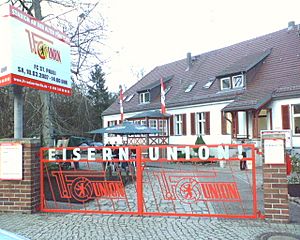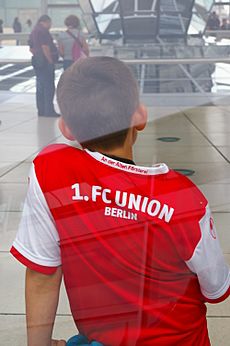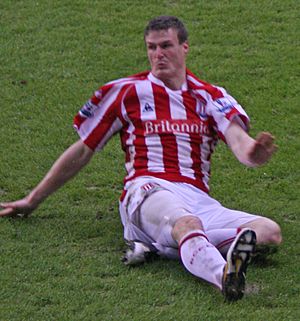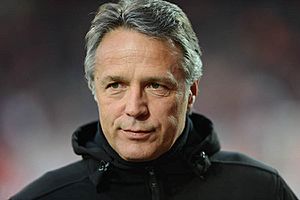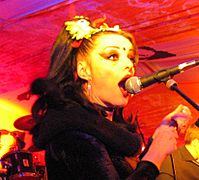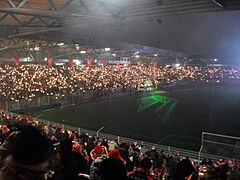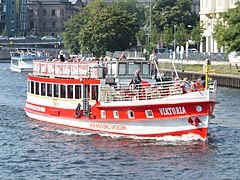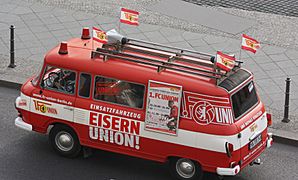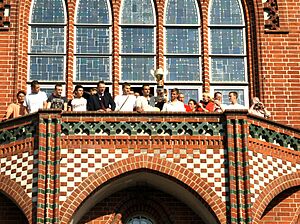1. FC Union Berlin facts for kids
 |
||
| Full name | 1. Fußballclub Union Berlin e. V. | |
|---|---|---|
| Nickname(s) | Die Eisernen (The Iron Ones) | |
| Founded | 20 January 1966 (preceded by FC Olympia Oberschöneweide, founded 1906) |
|
| Ground | Stadion An der Alten Försterei | |
| Capacity | 22,012 | |
| President | Dirk Zingler | |
| Head coach | Steffen Baumgart | |
| League | Bundesliga | |
| 2020–21 | Bundesliga, 7th of 18 | |
|
||
1. Fußballclub Union Berlin e. V., known as Union Berlin, is a professional German football club. It is based in Berlin, the capital city of Germany.
The club started in 1906 as FC Olympia Oberschöneweide. During the Cold War, Union Berlin was located in East Berlin. After Germany reunited in 1990, the club joined the German league system. From 2009 to 2019, they played in the 2. Bundesliga, which is the second-highest football league in Germany.
In 2019, Union Berlin made history by getting promoted to the Bundesliga for the first time. This is Germany's top football league. In 2021, they finished seventh in the league. This allowed them to play in the first-ever UEFA Europa Conference League. The next year, in 2022, the club finished fifth. This earned them a spot in the UEFA Europa League. In the 2022–23 season, Union Berlin achieved another first. They qualified for the Champions League by finishing fourth in the Bundesliga.
Union Berlin plays its home games at the Stadion An der Alten Försterei. This stadium is the second-largest in Berlin. It has been the home of Union Berlin and its earlier teams since it opened in 1920. The stadium also hosts music concerts and a yearly Christmas carols event called Weihnachtssingen.
As of early 2025, Union Berlin has over 70,000 official members. The club is famous for its passionate and creative fans. Their well-known chant is "Eisern Union" (Iron Union).
Contents
Club History
Early Years (1906–1945)
The club we know as 1. FC Union Berlin has a long history. It started as FC Olympia Oberschöneweide in 1906. This was in Oberschöneweide, a suburb of Berlin. In 1910, the team changed its name to SC Union 06 Oberschöneweide.
Union was one of Berlin's best clubs between World War I and World War II. They often won local championships. They also played at the national level. In 1923, they reached the German championship final. However, they lost 0–3 to Hamburger SV.
The team was first called "Schlosserjungs" (metalworker-boys). This was because their blue uniforms looked like the work clothes of factory workers in Oberschöneweide. The popular fan chant "Eisern Union!" (Iron Union!) also started around this time. From the beginning, the club was seen as a team for working-class people. This was different from other local clubs that had more middle-class backgrounds.
In 1933, German football was reorganized. Union became part of the Gauliga Berlin-Brandenburg. They usually had average results there. They were relegated in 1935 but returned to the top division in 1936. In 1940, they won their division title. They then played in the national playoffs but were knocked out by Rapid Wien.
After World War II: The Club Splits (1945–1961)
After World War II, all organizations in Germany were dissolved. A new sports group, SG Oberschöneweide, was formed in late 1945. They played in the city league. In 1947, they were promoted and won the division title. They became SG Union Oberschöneweide in 1948–49.
In the 1949–50 season, the club finished second in Berlin. They qualified for the national finals. But, due to rising tensions of the Cold War, Soviet authorities did not allow the team to travel. This led to a split. Most players and coaches moved to West Berlin. They formed Sport-Club Union 06 Berlin. This team played in the playoff match in Kiel, losing 0–7 to Hamburger SV.
The players who stayed in East Berlin continued as SG Union Oberschöneweide. The team in West Berlin, SC Union 06 Berlin, was strong until the Berlin Wall was built in 1961. The division of the city changed things for the West Berlin team.
Rebirth as Union Berlin (1961–1990)
The East Berlin part of the club changed names several times. It was Union Oberschöneweide (1950), BSG Motor Oberschöneweide (1951), SC Motor Berlin (1955), TSC Oberschöneweide (1957), and TSC Berlin (1963). Finally, it became 1. FC Union Berlin in 1966.
1. FC Union Berlin was officially founded on January 20, 1966. This happened during a big reorganization of East German football. Powerful figures like Herbert Warnke and Paul Verner supported its creation. They wanted a "civilian club" for working people in East Berlin. The club was founded in an industrial area. It was initially supported by the FDGB, a state-controlled trade union.
Even though it was a "civilian club," Union Berlin was part of the state sports system. Its leaders were often factory directors or political representatives. The club received state funding. All decisions had to be reported to the central sports agency, DTSB.
The support from the FDGB ended in 1975. Union Berlin then relied on support from local political leaders and state-owned companies. The club developed a strong rivalry with BFC Dynamo. BFC Dynamo was supported by the Stasi, a powerful state security service. While BFC Dynamo won many titles, Union Berlin often moved between the top and second leagues.
Union Berlin did win the East German Cup in 1968. They beat FC Carl Zeiss Jena 2–1. They also reached the cup final in 1986 but lost to 1. FC Lokomotive Leipzig.
The 2. Bundesliga Era (1990–2019)
After Germany reunited in 1990, Union Berlin played well on the field. However, they faced serious money problems. They managed to find sponsors and survive. They won their division in 1993 and 1994. But they were denied a license to play in the 2. Bundesliga because of their financial issues. The club almost went bankrupt again in 1997.
Union came close to reaching the 2. Bundesliga in 1998–99 and 1999–2000. They finally succeeded in 2000–01 under Bulgarian manager Georgi Vasilev. They easily won the Regionalliga Nord (third division) and moved up. That same year, they reached the final of the German Cup. They lost 0–2 to FC Schalke 04. They also played in the UEFA Cup, reaching the second round.
The club dropped to the Regionalliga Nord (third division) in 2004–05. Then they went down to the NOFV-Oberliga Nord (fourth division) in 2005–06. But they quickly returned to the third division after winning the Oberliga title. In 2008–09, Union became a founding club of the new 3. Liga. They won the league and were promoted to the 2. Bundesliga on May 10.
In 2011, there was a discussion about club president Dirk Zingler. It became known that he had been part of the Felix Dzerzhinsky Guards Regiment during his military service. This regiment was connected to the Stasi. Zingler explained he wanted to serve in Berlin and didn't know the regiment's connection beforehand. The club's press spokesman said that Union has a unique history, but they never claimed to be a "big anti-Stasi club."
On June 1, 2018, Swiss coach Urs Fischer became the new head coach. The team stayed in the second tier until the 2018–19 season. They earned their first promotion to the Bundesliga by beating VfB Stuttgart in the relegation play-offs. After the victory, fans celebrated on the pitch.
Bundesliga and European Football (2019–Present)
Union Berlin became the first Bundesliga club from former East Berlin. They were the sixth club from former East Germany to reach this level. Before their first Bundesliga season, the club signed new players like Neven Subotić and Anthony Ujah. They also re-signed Marvin Friedrich.
Their first-ever Bundesliga goal was scored by Sebastian Andersson in a 1–1 draw against Augsburg. On August 31, 2019, the club beat Borussia Dortmund 3–1 at home. This was their first Bundesliga win. The team finished the season in 11th place. Sebastian Andersson scored 12 goals.
On May 22, 2021, in their second Bundesliga season, Union Berlin qualified for the first UEFA Europa Conference League. They finished seventh after a 2–1 home win against RB Leipzig. Max Kruse scored the winning goal in the 92nd minute. This was Union Berlin's first European competition in twenty years.
In the 2022–23 season, the club finished fifth in the league. This qualified them for the Europa League, where they reached the round of 16. In the 2022–23 season, Union Berlin qualified for the Champions League group stage for the first time. They secured this with a 1–0 home win against Werder Bremen on the final matchday.
The 2023–24 season started poorly for the club. They had 14 winless matches in a row. Because of this, coach Urs Fischer left the club. After two more losses, Union dropped to 16th place. On the final matchday, they won 2–1 against Freiburg in stoppage time. This win kept them in the Bundesliga.
The Home Stadium: Stadion An der Alten Försterei
In 1920, SC Union Oberschöneweide needed a new home. Their old field was being used for new buildings. The club moved to Köpenick, a bit further from the city. The new stadium, Stadion An der Alten Försterei, opened officially in August 1920. The first game was between Oberschöneweide and the German champions 1. FC Nürnberg.
When Union was promoted to the DDR-Oberliga (East Germany's top league) in 1966, the stadium needed to be bigger. It was expanded in the 1970s and early 1980s. This increased the capacity to 22,500. However, the stadium's facilities became old and needed repairs.
After German reunification, the stadium was outdated. This made it harder for the club to get promoted to higher leagues. In 2008, the club decided to modernize the stadium. Money was tight, so over 2,000 Union fans helped build it themselves. They put in 140,000 hours of work. This made it Berlin's largest football-only stadium. During the renovation, Union played at the Friedrich-Ludwig-Jahn-Sportpark.
The stadium has many outdoor beer kiosks and grills. They serve traditional German food like bratwurst. The official opening was on July 12, 2013. It was celebrated with a friendly match against Scottish champions Celtic. The stadium holds 22,012 people, with 3,617 seats and the rest standing areas.
World Cup Living Room
In 2014, the club had a unique idea. They invited fans to bring their own sofas to the stadium for the entire World Cup. Fans could watch the televised matches on a big screen with other supporters. More than 800 sofas were placed on the pitch. This event won the Fan Experience Award in 2015.
Stadium Upgrades and European Games
In 2017, plans were announced to expand the Försterei from 22,012 to 37,000 seats. This would involve adding a new tier to three of the stands. The work was planned to start after the 2023/24 season. Union's President, Dirk Zingler, said that for the 2024/25 Season, Union Berlin would play at the Olympiastadion in former West Berlin.
In the 2021/22 season, Union Berlin played their UEFA Europa Conference League games at the Olympiastadion. This was because UEFA had a rule against standing terraces. This rule was changed in the 2022/23 season, allowing "safe standing." So, Union could play their 2022/23 UEFA Europa League matches at the Försterei.
For the 2023/24 UEFA Champions League, Dirk Zingler confirmed Union would again play at the Olympiastadion. This was due to high demand for tickets. The Försterei would be used for the UEFA Youth League. Union sold 120,000 tickets for all three home Champions League games in one day.
Club Organization
1. FC Union Berlin is largely run by its fans. Dirk Zingler has been the club's president since 2004. In 2022, the club had 41,088 registered members.
| President | From | To |
|---|---|---|
| Werner Otto | 20 June 1966 | 31 July 1967 |
| Heinz Müller | 1 August 1967 | 31 July 1970 |
| Paul Fettback | 1 August 1970 | 31 October 1973 |
| Heinz Hiillert | 1 November 1973 | 25 November 1975 |
| Günter Mielis | 26 November 1975 | 1 March 1982 |
| Dr. Norbert Woick | 2 March 1982 | 31 October 1983 |
| Klaus Brumm | 1 November 1983 | 20 December 1984 |
| Uwe Piontek | 21 December 1984 | 3 November 1987 |
| Hans-Günther Hansel | 4 November 1987 | 5 June 1990 |
| Gerhard Kalweit | 6 June 1990 | 31 July 1993 |
| Detlef Bracht | 17 August 1993 | 31 July 1994 |
| Horst Kahstein | 14 November 1994 | September 1997 |
| Heiner Bertram | 7 October 1997 | 12 October 2003 |
| Jürgen Schlebrowski | 13 October 2003 | 30 June 2004 |
| Dirk Zingler | 1 July 2004 |
Sport Management
- Oliver Ruhnert, since May 5, 2018
Sponsorships
Union Berlin has about 300 private and company partners.
| Period | Kit manufacturer | Shirt sponsor |
|---|---|---|
| 1998/99 | Nike | Skandia |
| 1999/2000 | BSR Gruppe | |
| 2000/01 | ||
| 2001/02 | ||
| 2002/03 | Saller | |
| 2003/04 | ||
| 2004/05 | ||
| 2005/06 | Nike | EastWest |
| 2006/07 | ||
| 2007/08 | Silicon Sensor | |
| 2008/09 | do you football | |
| 2009/10 | kfzteile24 | |
| 2010/11 | ||
| 2011/12 | Uhlsport | |
| 2012/13 | f.becker | |
| 2013/14 | ||
| 2014/15 | kfzteile24 | |
| 2015/16 | Macron | |
| 2016/17 | Layenberger | |
| 2017/18 | ||
| 2018/19 | ||
| 2019/20 | Aroundtown SA | |
| 2020/21 | Adidas | |
| 2021/22 | ||
| 2022/23 | Wefox |
Club Names Over Time
The history of 1. FC Union Berlin involves several different club names.
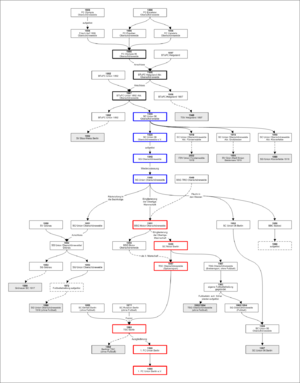
| Date | Name | Note |
|---|---|---|
| 17 June 1906 | FC Olympia Oberschöneweide | The club was founded as FC Olympia Oberschöneweide. |
| 22 July 1906 | BTuFC Helgoland, department Oberschöneweide | It joined BTuFC Helgoland as a third team. |
| 10 February 1907 | BTuFC Union 1892, department Oberschöneweide | It joined BTuFC Union 1892 as a fourth team. |
| 20 February 1909 | Union Oberschöneweide | It joined the football association Verband Berliner Ballspielvereine (VBB) as SC Union Oberschöneweide. |
| 1945 | SG Oberschöneweide | SC Union Oberschöneweide was dissolved by the Allied authorities. The club was refounded as SG Oberschöneweide. |
| December 1948 | SG Union Oberschöneweide | The club was allowed to use its old name again. |
| 1951 | BSG Motor Oberschöneweide | It joined with the enterprise sports community BSG Motor Oberschöneweide. The team colors changed to red and white. |
| 1 February 1955 | SC Motor Berlin | The first team joined the new sports club SC Motor Berlin. |
| 6 June 1957 | TSC Oberschöneweide | SC Motor Berlin merged with other sports communities to form TSC Oberschöneweide. |
| 18 February 1963 | TSC Berlin | It merged with other sports clubs to form TSC Berlin. |
| 20 January 1966 | 1. FC Union Berlin | The football part of TSC Berlin became a separate football club. This was the founding of 1. FC Union Berlin. |
Players
Current Team
|
|
Players on Loan
|
Famous Former Players
 Jörg Heinrich
Jörg Heinrich Robert Huth
Robert Huth Torsten Mattuschka
Torsten Mattuschka Marko Rehmer
Marko Rehmer Karim Benyamina
Karim Benyamina Sergej Barbarez
Sergej Barbarez Daniel Teixeira
Daniel Teixeira Sebastian Polter
Sebastian Polter Bobby Wood
Bobby Wood Max Kruse
Max Kruse Christian Gentner
Christian Gentner Taiwo Awoniyi
Taiwo Awoniyi Sebastian Andersson
Sebastian Andersson Julian Ryerson
Julian Ryerson Sheraldo Becker
Sheraldo Becker
All-Time Top Scorer
The club's all-time top scorer is Karim Benyamina from Algeria. He scored 87 goals in 213 games for the club. The number 22 jersey is not used by any player. This is a special honor for Benyamina's scoring record. In 2016, over 14,000 fans came to celebrate his career. They also honored Torsten Mattuschka, another club legend.
Women's Team
Union Berlin's women's team started in September 1969. It was the first women's team in Berlin. They played their first game on January 17, 1970. In 1971, the team joined KWO Berlin's women's team. KWO then merged with Union Berlin in June 1990 after German reunification.
Coaching Staff
| Role | Name |
|---|---|
| Head coach | |
| Assistant coach | |
| Assistant coach | |
| Assistant coach | |
| Goalkeeper coach | |
| Athletic trainer |
Managerial History
| 20 January 1965 | 30 June 1969 | |
| 1 Jul 1969 | 30 June 1970 | |
| 1 Jul 1970 | 30 June 1972 | |
| 1 Jul 1972 | 30 June 1974 | |
| 1 Jul 1974 | 6 Dec 1975 | |
| 7 Dec 1975 | 31 December 1975 | |
| 1 Jan 1976 | 18 July 1982 | |
| 19 July 1982 | 30 September 1983 | |
| 1 Okt. 1983 | 30 June 1984 | |
| 1 Jul 1984 | 31 December 1987 | |
| 1 Jan 1988 | 9 Apr 1990 | |
| 10 April 1990 | 30 June 1990 | |
| 1 Jul 1990 | 3 Jun 1992 | |
| 4 Jun 1992 | 30 June 1992 | |
| 1 Jul 1992 | 30 June 1994 | |
| 1 Jul 1994 | 25 January 1995 | |
| 26 January 1995 | 2 Oct 1995 | |
| 3 Oct 1995 | 24 March 1996 | |
| 25 March 1996 | 10 April 1996 | |
| 11 April 1996 | 25 September 1997 | |
| 26 September 1997 | 14 December 1997 | |
| 2 Jan 1998 | 30 September 1998 | |
| 30 September 1998 | 1 Jun 1999 | |
| 1 Jul 1999 | 12 October 2002 | |
| 13 October 2002 | 5 Nov 2002 | |
| 6 Nov 2002 | 24 March 2004 | |
| 25 March 2004 | 30 June 2004 | |
| 1 Jul 2004 | 27 September 2004 | |
| 28 September 2004 | 9 Dec 2004 | |
| 10 December 2004 | 19 December 2004 | |
| 20 December 2004 | 9 Dec 2005 | |
| 13 December 2005 | 5 Apr 2006 | |
| 6 Apr 2006 | 19 June 2007 | |
| 20 June 2007 | 12 May 2014 | |
| 1 July 2014 | 31 August 2015 | |
| 1 September 2015 | 4 March 2016 | |
| 5 March 2016 | 30 June 2016 | |
| 1 July 2016 | 4 December 2017 | |
| 4 December 2017 | 20 May 2018 | |
| 1 June 2018 | 15 November 2023 | |
| 15 November 2023 | 26 November 2023 | |
| 26 November 2023 | 6 May 2024 | |
| 6 May 2024 | 30 June 2024 | |
| 1 July 2024 | 27 December 2024 | |
| 2 January 2025 | present |
European Competitions
Overview of Matches
| Competition | S | Pld | W | D | L | GF | GA | GD |
|---|---|---|---|---|---|---|---|---|
| UEFA Champions League | 1 | 6 | 0 | 2 | 4 | 6 | 10 | −4 |
| UEFA Europa League/UEFA Cup | 2 | 14 | 6 | 4 | 4 | 14 | 13 | +1 |
| UEFA Europa Conference League | 1 | 8 | 3 | 2 | 3 | 12 | 9 | +3 |
| Intertoto Cup | 2 | 12 | 5 | 2 | 5 | 15 | 12 | +3 |
| Total | 6 | 40 | 14 | 10 | 16 | 47 | 44 | +3 |
European Match Results
- Union Berlin score listed first.
| Season | Competition | Round | Opposition | Home | Away | Agg. |
|---|---|---|---|---|---|---|
| 1967–68 | Intertoto Cup | Group B7 | 0–3 | 0–1 | 3rd place | |
| 3–0 | 0–1 | |||||
| 0–1 | 1–1 | |||||
| 1986–87 | Intertoto Cup | Group 2 | 3–2 | 0–3 | 1st place | |
| 1–0 | 1–1 | |||||
| 4–1 | 2–1 | |||||
| 2001–02 | UEFA Cup | 1R | 3–0 | 1–1 | 4–1 | |
| 2R | 0–2 | 0–0 | 0–2 | |||
| 2021–22 | UEFA Europa Conference League | PO | 0–0 | 4–0 | 4–0 | |
| Group E | 1–1 | 1–3 | 3rd place | |||
| 1–2 | 1–3 | |||||
| 3–0 | 1–0 | |||||
| 2022–23 | UEFA Europa League | Group D | 0–1 | 1–0 | 2nd place | |
| 1–0 | 0–1 | |||||
| 1–0 | 1–0 | |||||
| KRPO | 3–1 | 0–0 | 3–1 | |||
| R16 | 3–3 | 0–3 | 3–6 | |||
| 2023–24 | UEFA Champions League | Group C | 2–3 | 0–1 | 4th place | |
| 2–3 | 1–1 | |||||
| 0–1 | 1–1 |
Player Records
Most Appearances
These are competitive, professional matches only, as of September 24, 2024.
Top Goalscorers
These are competitive, professional matches only, as of September 24, 2024.
| Rank | Player | Years | League | Cup | Europe | Total (Apps) | Ratio |
|---|---|---|---|---|---|---|---|
| 1 | 1990–1994 | 66 | 0 | 0 | 66 (118) | 0.56 | |
| 2 | 2005–2011 | 62 | 0 | 0 | 62 (192) | 0.32 | |
| 3 | 2005–2014 | 60 | 1 | 0 | 61 (281) | 0.22 | |
| 4 | 1993–1996 | 48 | 0 | 0 | 48 (92) | 0.52 | |
| 5 | 2001, 2005–2007 | 47 | 0 | 0 | 47 (68) | 0.69 | |
| 6 | 2014–2015, 2017–2020 | 44 | 2 | 0 | 46 (104) | 0.44 | |
| 7 | 1993–1995 | 43 | 1 | 0 | 44 (83) | 0.53 | |
| 1994–1998, 2006–2009 | 43 | 1 | 0 | 44 (140) | 0.31 | ||
| 9 | 1998–2003 | 38 | 2 | 0 | 40 (164) | 0.24 | |
| 10 | 1991–1994, 1997–1998 | 37 | 0 | 0 | 37 (92) | 0.40 |
Club Culture and Traditions
1. FC Union Berlin is known as a "cult" club in Europe. This is because of its unique fan and club activities over the past twenty years.
The club's nicknames are Eiserne (the Iron Ones) or Eisern Union (Iron Union). These names came from an older nickname, Schlosserjungs (metalworker boys). This referred to their blue uniforms, which looked like the work clothes of local factory workers.
In May 2004, fans helped save the club financially. They raised enough money to keep the club's license for the fourth division. This was part of a campaign called 'Bleed for Union'. Fans donated blood to hospitals and gave the money they received to the club.
After 2010, Union Berlin became popular with new residents of Berlin, including people from other countries. They were attracted to the club's special atmosphere.
In 2023, the entertainment brand Wildz became a main sponsor of the club.
Club Rivalries
During the East German era, 1. FC Union Berlin had a rivalry with BFC Dynamo. BFC Dynamo was linked to the powerful state security service of East Germany, known as the Stasi. Union, on the other hand, was supported by local political leaders and state-owned businesses. Union was seen as a club for the working class and had a strong identity. BFC Dynamo won many league titles, which fueled the rivalry. Fans of both teams sometimes clashed. Union became the most popular club in East Berlin.
Fans of Union Berlin saw their club as an underdog. They were known for being stubborn and not always following the rules. However, this image should not be confused with actual political resistance. Many Union supporters were just normal football fans. They were interested in the game and their club.
Even though 1. FC Union Berlin and Hertha BSC are the two biggest clubs in Berlin, their rivalry has been less intense. Fans of both clubs often showed support for each other when Berlin was divided. Hertha fans visited Union's stadium, and Union fans traveled with Hertha when they played in other countries. Chants like "Hertha and Union – one nation" became popular.
The two fan groups met for the first time after the Berlin Wall fell. This was at an indoor tournament in January 1990. The teams of Hertha BSC and 1. FC Union Berlin played each other for the first time on January 19, 1990. Hertha BSC won 3–2.
On January 27, 1990, Hertha hosted Union Berlin in a friendly match. Over 52,000 fans attended. Fans paid with both East and West German money. They sang songs about German reunification. Hertha won 2–1.
More than twenty years later, on September 17, 2010, the clubs played their first competitive match. It was a 2. Bundesliga game at the Stadion An der Alten Försterei, ending in a 1–1 draw. On November 2, 2019, Union Berlin played Hertha in their first top-flight match. Union won 1–0 with a late penalty from Sebastian Polter. The game was briefly stopped because Hertha fans threw fireworks. After the game, Union Berlin goalkeeper Rafał Gikiewicz was praised for helping to calm down Union fans who went onto the field.
Union Berlin also has rivalries with Hansa Rostock, Dynamo Dresden, and Magdeburg. These rivalries started when the teams played in the DDR-Oberliga.
More recently, a rivalry has grown with RB Leipzig. This club was formed with funding from Red Bull GmbH. In 2011, Union Berlin ran ads against the club's investment. They also canceled a friendly match with them. On September 21, 2014, Union Berlin fans held a silent protest for the first 15 minutes of a game against RB Leipzig. They called RB Leipzig a "marketing product." Union Berlin won that game 2–1. On August 18, 2019, during Union Berlin's first Bundesliga game against RB Leipzig, the club's oldest fan group called for a 15-minute silent protest at the start of the match.
Club Songs
The official Union Berlin song is "Eisern Union" by German punk singer Nina Hagen. It was recorded in 1998. The famous fan chant 'Eisern Union' is sung back and forth between different parts of the stadium.
Christmas Tradition
Union Berlin is also known for its Christmas traditions at their home stadium. In 2003, the yearly Union Weihnachtssingen (Christmas carols singing) began. Only 89 fans showed up then. By 2013, 27,500 people attended, including players and fans from other teams. Fans drink mulled wine, wave candles, and sing Christmas carols mixed with football chants.
Club Mascot
Ritter Keule (Cudgel the Knight) is the mascot of Union Berlin. He was first introduced in 2000.
Honours
Domestic Titles
- German Football Championship
- Runners-up: 1923
- DDR-Liga Nord (Second Division)
- Winners: 1965–66, 1969–70
- Runners-up: 1963–64
- DDR-Liga B (Second Division)
- Winners: 1973–74, 1974–75, 1975–76, 1980–81, 1981–82
- DDR-Liga A (Second Division)
- Winners: 1984–85, 1990–91
- Runners-up: 1989–90
- 3. Liga (Third Division)
- Winners 2008–09
- II. DDR-Liga I (Third Division)
- Winners: 1961–62
- German Cup
- Runners-up: 2000–01
- East German Cup:
- Winners: 1967–68
- Runners-up: 1985–86
Regional Titles
- Berlin/Brandenburg Champions (−1933)
- Winners: 1920, 1923
- Runners-up: 1917, 1925
- Gauliga Berlin-Brandenburg:
- Winners: 1940
- Oberliga Berlin (1945–63):
- Winners: 1947–48
- Runners-up: 1949–50
- NOFV-Oberliga Mitte (Third Division)
- Winners: 1991–92, 1992–93, 1993–94
- Regionalliga Nordost (Third Division)
- Winners: 1999–2000
- Runners-up: 1995–96
- Regionalliga Nord (Third Division)
- Winners: 2000–01
- NOFV-Oberliga Nord (Fourth Division)
- Winner: 2005–06
- Berlin Cup (Tiers III–VII)
- Winners: 1947, 1948, 1994, 2007, 2009
- Runners-up: 1926, 1997
Youth Titles
- East German Youth Championship
- Runners-up: 1985, 1988
- East German Junior Cup
- Winners: 1960
Season Performance

See also
 In Spanish: F. C. Union Berlin para niños
In Spanish: F. C. Union Berlin para niños
- Football in Germany
- Football in Berlin
- Sport in Berlin



